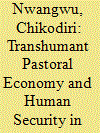|
|
|
Sort Order |
|
|
|
Items / Page
|
|
|
|
|
|
|
| Srl | Item |
| 1 |
ID:
172358


|
|
|
|
|
| Summary/Abstract |
It is difficult now to determine how much resistance there was to Roman rule in North Africa because of the almost complete absence of evidence for the sentiments of the region’s non-Roman population. A small number of so-called ‘Libyan’ inscriptions survive on stone, but the texts, where they can be deciphered, reveal little. Armed resistance to Roman rule seems to have been sporadic and mostly small-scale, at least in the period before about 250 CE. The most significant threat to the region’s security was the rebellion of the Musulamii led by Tacfarinas, which began in 17 CE and lasted until 24. But Roman rule itself was not seriously threatened, because Tacfarinas could not defeat the Romans in battle. After the death of Tacfarinas, resistance to Roman rule appears to have been centered in the highlands of what is now north-western Algeria. The Roman army, which functioned primarily as an internal security force in north Africa, seems to have had trouble monitoring, and therefore controlling, the tribal peoples who lived in the mountains, and, to a lesser extent, the transhumant, semi-nomadic populations of the region, who moved their flocks and herds north in the summer and south in the winter.
|
|
|
|
|
|
|
|
|
|
|
|
|
|
|
|
| 2 |
ID:
161352


|
|
|
|
|
| Summary/Abstract |
This article challenges the ahistorical figure of the ‘steppe nomad’ by presenting some of the main characteristics of Kazakh nomadic pastoralism, which vary widely in time and space. It compares two ethnographic studies conducted a century apart in the same place in south-eastern Kazakhstan: a statistical survey from 1910 and an account of a transhumance in which the author took part in June 2012. Sedentary pastoralism now prevails in Kazakhstan, but a system of seasonal pastures endures in some areas. In Raĭymbek District (Almaty Province), vertical nomadism takes advantage of the altitudinal variations of vegetation and climate. This article demonstrates both the continuity of nomadic routes despite successive crises during the twentieth century, and considers the overall change from quasi-nomadism to quasi-sedentarism. This comparison a century apart also fosters dialogue between history and social anthropology through a dual synchronic approach, seeking to restore historicity to our understanding of pastoral nomadism.
|
|
|
|
|
|
|
|
|
|
|
|
|
|
|
|
| 3 |
ID:
167646


|
|
|
|
|
| Summary/Abstract |
Shepherds have a particular place in the history and culture of Romania. For centuries they have had rights to graze their sheep in public pastures and manage their flocks using traditional methods. Changes at the national and European level have threatened this way of life and provoked protest, most recently in December 2015 over plans to limit sheepdog numbers and restrict winter grazing rights. This article draws on interviews with participating and non-participating shepherds to examine the motivations behind the protest action and its relation to their position in contemporary society. The findings suggest how marginalised groups in society are able to draw on folk histories and cultural identities in the formulation of contentious politics in defence of their interests. The post-communist setting of the protests also highlights the persistence of traditional practices during a period of social and political upheaval.
|
|
|
|
|
|
|
|
|
|
|
|
|
|
|
|
| 4 |
ID:
175107


|
|
|
|
|
| Summary/Abstract |
The limited access to land in most African states has engendered a fierce competition, especially among various agricultural user groups. The two major groups of agricultural land users are transhumant pastoralists and sedentary peasant farmers. The internecine conflict between these agro-user groups has grave implications for human security in Nigeria and beyond. Explanation of the conflict has centred on climate change and environmental security, population growth and urbanisation, and insecurity. However, the transnational character of this conflict, often made possible by relevant regional protocols, has not received adequate scholarly attention. This paper argues that networking of regional bodies and other stakeholders is the panacea for tackling the tension-soaked relationship between these land users.
|
|
|
|
|
|
|
|
|
|
|
|
|
|
|
|
|
|
|
|
|